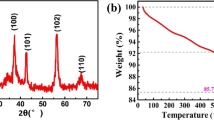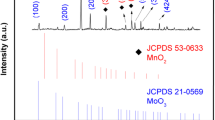Abstract
This work presents the construction of a reversible zinc ion battery using components recovered from exhausted Zn/C primary cells. The reduced cathode material from the primary battery served as raw material to synthesize birnessite-type manganese oxide, which, when working as a cathode in conjunction with an aqueous electrolyte and a recovered zinc anode, exhibits a reversible capacity of 289 mAh g−1 at 20 mA g−1. This performance is similar to that observed for manganese oxide synthesized from potassium permanganate reagent (270 mAh g−1 at 20 mA g−1). The structural characterization shows that the material obtained from recycling activities changes its morphology and surface area due to the presence of sodium ions during the synthesis process, and these remain in their structure. These changes promote a 60% capacity lost after being cycled at different charges, compared to 26% of δ-MnO2 synthesized from permanganate reagent. The long-term stability test shows that both batteries can retain their capacity after 1000 discharge/charge cycles at a load of 1000 mA g−1. The results support the sustainability of using a primary cell residue to get an electric energy storage device again.







Similar content being viewed by others
References
Winter M, Brood RJ (2004) What are batteries, fuel cells, and supercapacitors. Chem Rev. https://doi.org/10.1021/cr020730k
Manthiram A (2017) An outlook on lithium ion battery technology. ACS Cent Sci. https://doi.org/10.1021/acscentsci.7b00288
Liang Y, Zhao C-Z, Yuan H, Chen Y, Zhang W, Huang J-Q, Yu D, Liu Y, Titrici M-M, Chueh Y-L, Yu H, Zhang Q (2019) A review of rechargeable batteries for portable electronic devices. InfoMat. https://doi.org/10.1002/inf2.12000
Wang Y, Song Y, Xia Y (2016) Electrochemical capacitors: mechanism, materials, systems, characterization, and applications. Chem Soc Rev. https://doi.org/10.1039/C5CS00580A
Prasad GG, Shetty N, Thakur S, Bommegowda R, Bommegowda KB (2019) Supercapacitor technology and its applications: a review. IOP Conf Ser: Mater Sci. https://doi.org/10.1088/1757-899X/561/1/012105
Soloveichik GL (2015) Flow batteries: current status and trends. Chem Rev. https://doi.org/10.1021/cr500720t
Ye R, Henkensmeier D, Yoon SJ, Huang Z, Kim DK, Chang Z, Kim S, Chen R (2018) Redox flow batteries for energy storage: a technology review. J Electrochem En Conv Stor doi 10(1115/1):4037248
Ding Y, Guo X, Yu G (2020) Next-generation liquid metal batteries based on the chemistry of fusible alloys. ACS Cent Sci. https://doi.org/10.1021/acscentsci.0c00749
Hwang J-Y, Myung S-T, Sun YK (2017) Sodium-ion batteries: present and future. Chem Soc Rev. https://doi.org/10.1039/C6CS00776G
Perveen T, Siddiq M, Shahzad N, Ihsan R, Ahmad A, Shahzad MI (2020) Prospects in anode materials for sodium ion batteries — a review. Renew Sust Energy Rev. https://doi.org/10.1016/j.rser.2019.109549
Hosaka T, Kubota K, Hameed AS, Komaba S (2020) Research development on K-ion batteries. Chem Rev. https://doi.org/10.1021/acs.chemrev.9b00463
Rajagopalan R, Tang Y, Ji X, Jia CH, Wang H (2020) Advancements and challenges in potassium ion batteries: a comprehensive review. Adv Func Mater. https://doi.org/10.1002/adfm.201909486
Sun X, Duffort V, Mehdi BL, Browning ND, Nazar LF (2016) Investigation of the mechanism of Mg insertion in birnessite in nonaqueous and aqueous rechargeable Mg-ion batteries. Chem Mater. https://doi.org/10.1021/acs.chemmater.5b03983
Wang F, Fan X, Gao T, Sun W, Ma Z, Yang CH, Han F, Xu K, Wang Ch (2017) High voltage aqueous magnesium ion batteries. ACS Cent Sci. https://doi.org/10.1021/acscentsci.7b00361
Xu Ch, Li B, Du H, Kang F (2012) Energetic zinc ion chemistry: the rechargeable zinc ion battery. Angew Chem Int Ed. https://doi.org/10.1002/anie.201106307
Zhang L, Chen L, Zhou X, Liu X (2014) Towards high-voltage aqueous metal-ion batteries beyond 1.5 V: the zinc/zinc hexacyanoferrate system. Adv Energy Mater. https://doi.org/10.1002/aenm.201400930
Alfaruqi MH, Mathew V, Gim J, Kim S, Song J, Baboo JP, Choi SH, Kim J (2015) Electrochemically induced structural transformation in a γ-MnO2 cathode of high-capacity zinc-ion battery system. Chem Mater. https://doi.org/10.1021/cm504717p
He P, Quan Y, Xu X, Yan M, Yang W, An Q, He L, Mai L (2017) High-performance aqueous zinc-ion battery based on layered H2V3O8 nanowire cathode. Small. https://doi.org/10.1002/smll.201702551
Corpuz RD, De Juan LMZ, Praserthdam S, Pornprasertsuk R, Yonezawa T, Nguyen MY, Khaewhom S (2019) Annealing induced a well-ordered single crystal δ-MnO2 and its electrochemical performance in zinc-ion battery. Sci Rep. https://doi.org/10.1038/s41598-019-51692-x
Wang D, Wang L, Liang G, Li H, Liu Z, Tang Z, Liang J, Zhi Ch (2019) A superior δ-MnO2 cathode and a self-healing Zn-δ-MnO2 battery. ACS Nano. https://doi.org/10.1021/acsnano.9b04916
Yadav GG, Turney D, Huang J, Wei X, Banerjee S (2019) Breaking the 2 V barrier in aqueous zinc chemistry: creating 2.45 and 2.8 V MnO2-Zn aqueous batteries. ACS Energy Lett. https://doi.org/10.1021/acsenergylett.9b01643
Zhang N, Cheng F, Liu J, Wang L, Long X, Liu X, Li F, Chen J (2017) Rechargeable aqueous zinc-manganese dioxide batteries with high energy and power densities. Nature Comm. https://doi.org/10.1038/s41467-017-00467-x
Wang X, Wang F, Wang L, Li M, Wang Y, Chen B, Zhu Y, Fu L, Zha L, Zhang L, Wu Y, Huang Y (2016) An aqueous rechargeable Zn//Co3O4 battery with high energy density and good cycling behavior. Adv Mater. https://doi.org/10.1002/adma.201505370
Wu X, Xiang Y, Peng Q, Wu X, Li Y, Tang F, Song R, Liu Z, He Z, Wu X (2017) Green-low-cost rechargeable aqueous zinc-ion-batteries using hollow porous spinel ZnMnO4 as cathode material. J Mater Chem A. https://doi.org/10.1039/C7TA00100B
Li G, Yang Z, Jiang Y, Jin Ch, Huang W, Ding X, Huang Y (2016) Towards polyvalent ion batteries: a zinc-ion battery based on NASICON structured Na3V2(PO4)3. Nano Energy. https://doi.org/10.1016/j.nanoen.2016.04.051
Jia Z, Wang B, Wang Y (2015) Copper hexacyanoferrate with well-defined open framework as a positive electrode for aqueous zinc ion batteries. Mater Chem Phys. https://doi.org/10.1016/j.matchemphys.2014.11.014
Hashemzadeh F, Motlagh MMK, Maghsoudipour A (2009) A comparative study of hydrothermal and sol-gel methods in the synthesis of MnO2 nanostructures. J Sol-Gel Sci Technol. https://doi.org/10.1007/s10971-009-1978-2
Zhu G, Li H, Deng L, Liu Z-H (2010) Low-temperature synthesis of δ-MnO2 with large surface area and its capacitance. Mater Lett. https://doi.org/10.1016/j.matlet.2010.05.019
Xie Y, Yu Y, Gong X, Guo Y, Guo Y, Wang Y, Lu G (2015) Effect of the crystal plane figure on the catalytic performance of MnO2 for the total oxidation of propane. CrystEngComm. https://doi.org/10.1039/C5CE00058K
McLarnon FR, Cairns EJ (1991) The secondary alkaline zinc electrode. J Electrochem Soc. https://doi.org/10.1149/1.2085653
Alkaline Primary Batteries Global Market Report 2021: COVID-19 Impact and Recovery to 2030 (2021) https://www.researchandmarkets.com/reports/5323117/alkaline-primary-batteries-global-market-report
Jia Z, Wang J, Wang Y, Li B, Wang B, Qi T, Wang X (2016) Interfacial synthesis of δ-MnO2 nano-sheets with a large surface area and their application in electrochemical capacitors. J Mater Sci Tech. https://doi.org/10.1016/j.jmst.2015.08.003
Sotomayor FJ, Cychocz KA, Thommes M (2018) Characterization of micro/mesoporous materials physisorption: concepts and case studies. Acc Mater Suf Res 3(2):34–50
Alfaruqi MH, Gim J, Kim S, Song J, Pham DT, Jo J, Xiu Z, Mathew V, Kim J (2015) A layered δ-MnO2 nanoflake cathode with high zinc-storage capacities for eco-friendly battery applications. Comm Electrochem. https://doi.org/10.1016/j.elecom.2015.08.019
Acknowledgements
The authors thank Ignacio A. Rivero, E. A. Reynoso-Soto, S. Perez-Sicairos, and M. Eloisa Aparicio Ceja for the technical assistance.
Author information
Authors and Affiliations
Corresponding author
Ethics declarations
Conflict of interest
The authors declare no competing interests.
Additional information
Publisher's Note
Springer Nature remains neutral with regard to jurisdictional claims in published maps and institutional affiliations.
Rights and permissions
Springer Nature or its licensor holds exclusive rights to this article under a publishing agreement with the author(s) or other rightsholder(s); author self-archiving of the accepted manuscript version of this article is solely governed by the terms of such publishing agreement and applicable law.
About this article
Cite this article
García-López, M.A., Oropeza-Guzmán, M.T. & Calva-Yáñez, J.C. Reclaimed δ-MnO2 from exhausted Zn/C primary cells as active cathode in secondary Zn2+ ion batteries. J Solid State Electrochem 26, 2479–2489 (2022). https://doi.org/10.1007/s10008-022-05257-0
Received:
Revised:
Accepted:
Published:
Issue Date:
DOI: https://doi.org/10.1007/s10008-022-05257-0




